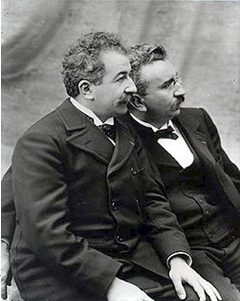When watching a movie have you ever noticed how many shots are in a scene; or how one scene changes into the next? “Film editing is often referred to as the ‘invisible art’ because when it is well-practiced, the viewer can become so engaged that he or she is not even aware of the editors work." This happens to most viewers because the editor’s cuts are so seamlessly put together, giving it a fluid nonstop appearance.
The first moving film was shown to the public in 1895, credited by the Lumiere brothers, Auguste and Louis.
The first moving film was shown to the public in 1895, credited by the Lumiere brothers, Auguste and Louis.

Together they had created the cinematograph; this functioned as a projector, printer, and camera all in one.

It is thought that Edwin S. Porter was the person who first used editing in 1903. Film editing was originally done with a positive copy of the film negative Then, “by physically cutting and pasting together pieces of film, using a splicer and threading the film on a machine.”
In silent films, the movie makers needed a way to get dialogue across. They did this by filming a title card; also known as an intertitle, giving printed narration to the film “The development of the soundtrack slowly eliminated their utility as a narrative device.”
Originally movies were silent. “The closest to sound that the movies achieved was music in the background played on a phonograph. Not only was music played by a phonograph, but the movies would often be accompanied with live performances that adapted with the scene. To create the special sound effects with the film, theater organs were used.
In 1927 sound was finally achieved within a film. Warner Brothers played a big part in revolutionizing film and its industry, with its production of The Jazz Singer; it contained a scene where people actually spoke with sound.
The device they used to create sound in films was a wax record, which would be synchronized with the film projector later. This was created by Western Electric with the help of Warner Brothers.
In 1927 sound was finally achieved within a film. Warner Brothers played a big part in revolutionizing film and its industry, with its production of The Jazz Singer; it contained a scene where people actually spoke with sound.
The device they used to create sound in films was a wax record, which would be synchronized with the film projector later. This was created by Western Electric with the help of Warner Brothers.

Films such as the Great Train Robbery are an example of the first signs of editing in films. Along with early editing dialogue by the use of filming title cards. Year’s later sound in film had arrived with The Jazz Singer being one of the first films with sound. Since the beginning of the creation of film we have come a long way from editing, dialogue, and sound within our movies today.

Sources:
Unknown. "LUMIERE BROTHERS FILMS - HISTORY." HoloNet. Unknown. Web. 08 Oct. 2011. <http://www.holonet.khm.de/visual_alchemy/lumiere.html>.
Wikipedia. "Film Editing." Wikipedia, the Free Encyclopedia. Wikipedia, 30 Sept. 2011. Web. 08 Oct. 2011. <http://en.wikipedia.org/wiki/Film_editing>.
Unknown. "Film History." Film History. Cinema City. Web. 8 Oct. 2011. <http://library.thinkquest.org/28930/film.htm#>.
Unknown. "A Brief History of Silent Movies." Buzzle Web Portal: Intelligent Life on the Web. Web. 08 Oct. 2011. <http://www.buzzle.com/articles/a-brief-history-of-silent-movies.html>.
Unknown. "Talking Motion Pictures." American Studies @ The University of Virginia. Web. 08 Oct. 2011. <http://xroads.virginia.edu/~ug00/3on1/movies/talkies.html>.
"Intertitle." Wikipedia, the Free Encyclopedia. Wikipedia, 14 Sept. 2011. Web. 10 Oct. 2011. <http://en.wikipedia.org/wiki/Intertitle>.




No comments:
Post a Comment